Report on Development of Light Rail Transit Framework in Brisbane
VerifiedAdded on 2020/03/04
|18
|4062
|306
Report
AI Summary
This report focuses on the development of a light rail transit (LRT) framework, specifically for Brisbane. It begins with an executive summary outlining the project's goals, including reducing congestion and improving transportation efficiency. The report details the objectives, which include minimizing road congestion, reducing pollution, and implementing a priority strategy. It covers system operational requirements, maintenance, and technical performance measures. The conceptual design section outlines preliminary system design, functional analysis, and design criteria, including cost estimations. Detailed design and development aspects, such as documentation and engineering tools, are also discussed. The report analyzes the benefits of LRT, including increased capacity and reduced environmental impact, while also addressing challenges like land management and framework development. The report also includes recommendations for successful implementation, emphasizing the need for efficient track design, power supply, and passenger capacity. This report provides a comprehensive overview of the LRT framework development process, addressing both technical and strategic considerations.
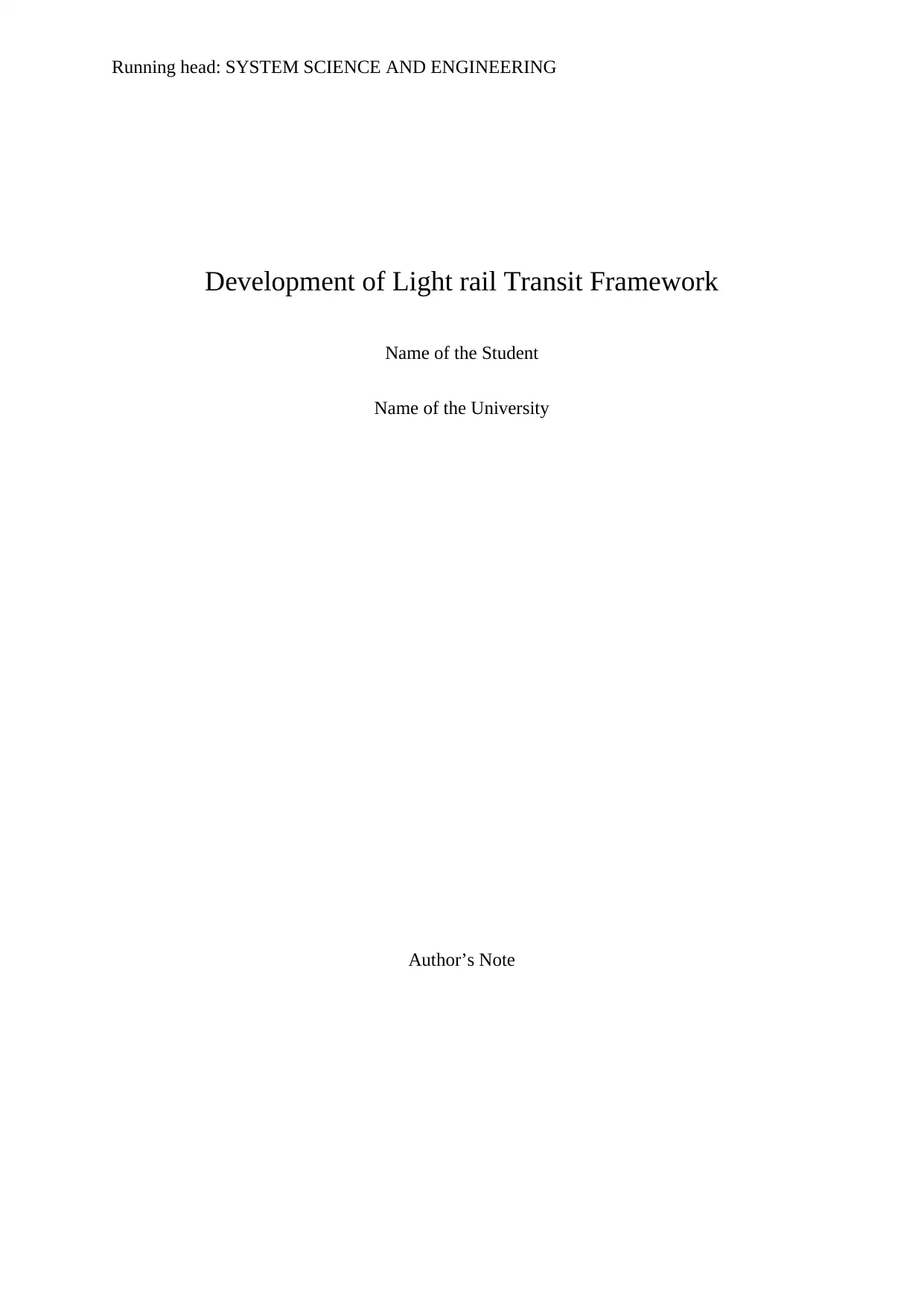
Running head: SYSTEM SCIENCE AND ENGINEERING
Development of Light rail Transit Framework
Name of the Student
Name of the University
Author’s Note
Development of Light rail Transit Framework
Name of the Student
Name of the University
Author’s Note
Paraphrase This Document
Need a fresh take? Get an instant paraphrase of this document with our AI Paraphraser
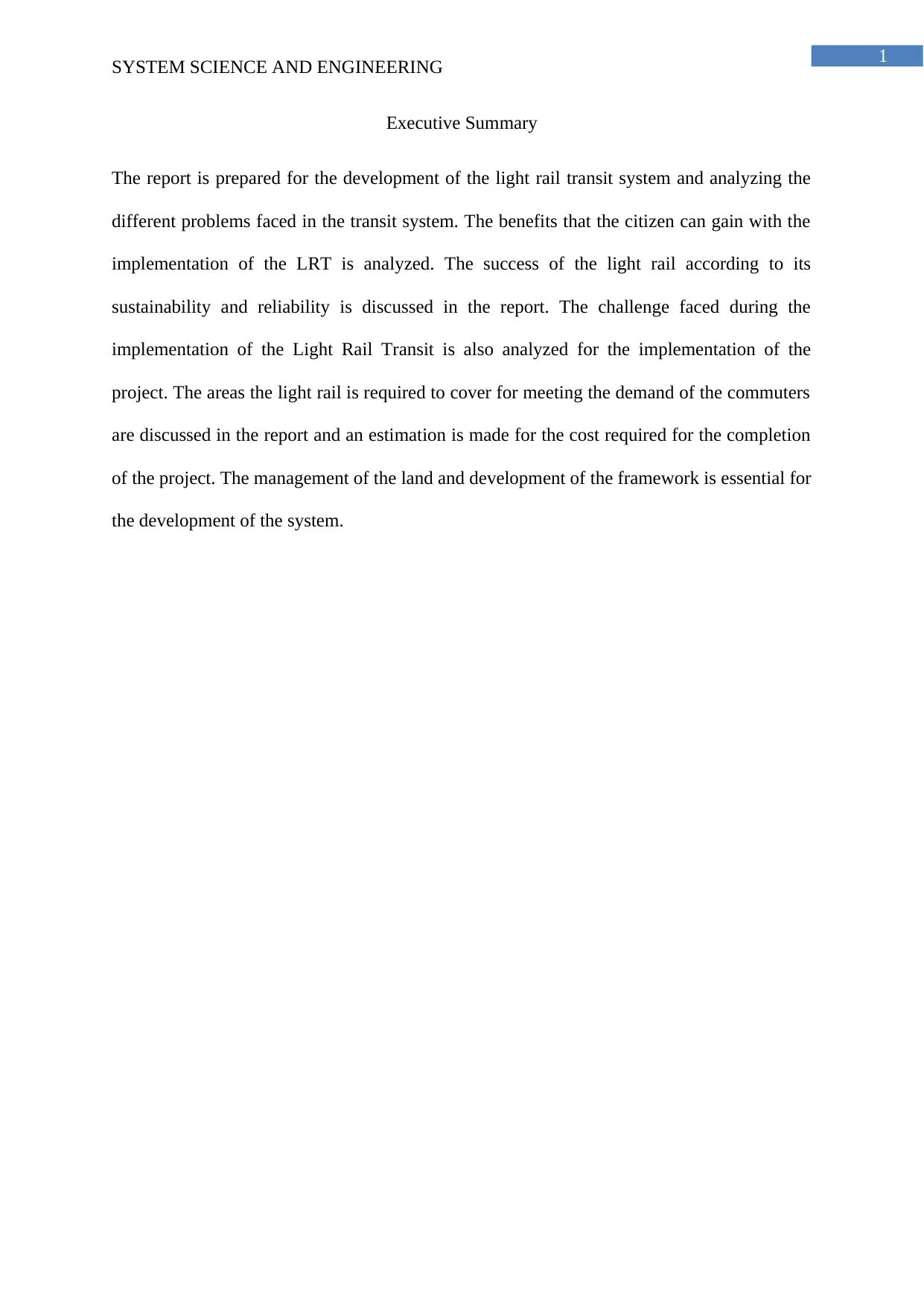
1
SYSTEM SCIENCE AND ENGINEERING
Executive Summary
The report is prepared for the development of the light rail transit system and analyzing the
different problems faced in the transit system. The benefits that the citizen can gain with the
implementation of the LRT is analyzed. The success of the light rail according to its
sustainability and reliability is discussed in the report. The challenge faced during the
implementation of the Light Rail Transit is also analyzed for the implementation of the
project. The areas the light rail is required to cover for meeting the demand of the commuters
are discussed in the report and an estimation is made for the cost required for the completion
of the project. The management of the land and development of the framework is essential for
the development of the system.
SYSTEM SCIENCE AND ENGINEERING
Executive Summary
The report is prepared for the development of the light rail transit system and analyzing the
different problems faced in the transit system. The benefits that the citizen can gain with the
implementation of the LRT is analyzed. The success of the light rail according to its
sustainability and reliability is discussed in the report. The challenge faced during the
implementation of the Light Rail Transit is also analyzed for the implementation of the
project. The areas the light rail is required to cover for meeting the demand of the commuters
are discussed in the report and an estimation is made for the cost required for the completion
of the project. The management of the land and development of the framework is essential for
the development of the system.
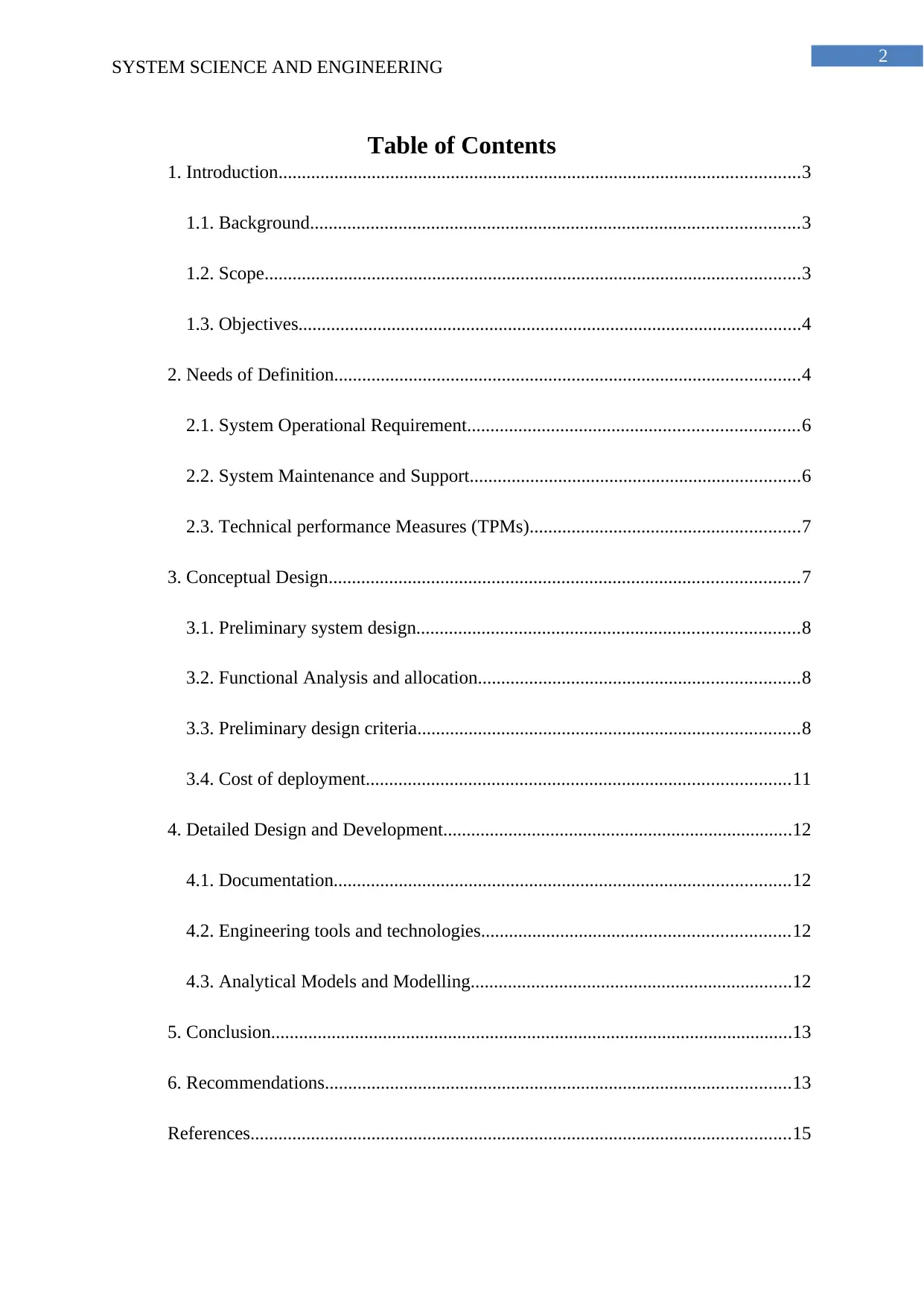
2
SYSTEM SCIENCE AND ENGINEERING
Table of Contents
1. Introduction................................................................................................................3
1.1. Background.........................................................................................................3
1.2. Scope...................................................................................................................3
1.3. Objectives............................................................................................................4
2. Needs of Definition....................................................................................................4
2.1. System Operational Requirement.......................................................................6
2.2. System Maintenance and Support.......................................................................6
2.3. Technical performance Measures (TPMs)..........................................................7
3. Conceptual Design.....................................................................................................7
3.1. Preliminary system design..................................................................................8
3.2. Functional Analysis and allocation.....................................................................8
3.3. Preliminary design criteria..................................................................................8
3.4. Cost of deployment...........................................................................................11
4. Detailed Design and Development...........................................................................12
4.1. Documentation..................................................................................................12
4.2. Engineering tools and technologies..................................................................12
4.3. Analytical Models and Modelling.....................................................................12
5. Conclusion................................................................................................................13
6. Recommendations....................................................................................................13
References....................................................................................................................15
SYSTEM SCIENCE AND ENGINEERING
Table of Contents
1. Introduction................................................................................................................3
1.1. Background.........................................................................................................3
1.2. Scope...................................................................................................................3
1.3. Objectives............................................................................................................4
2. Needs of Definition....................................................................................................4
2.1. System Operational Requirement.......................................................................6
2.2. System Maintenance and Support.......................................................................6
2.3. Technical performance Measures (TPMs)..........................................................7
3. Conceptual Design.....................................................................................................7
3.1. Preliminary system design..................................................................................8
3.2. Functional Analysis and allocation.....................................................................8
3.3. Preliminary design criteria..................................................................................8
3.4. Cost of deployment...........................................................................................11
4. Detailed Design and Development...........................................................................12
4.1. Documentation..................................................................................................12
4.2. Engineering tools and technologies..................................................................12
4.3. Analytical Models and Modelling.....................................................................12
5. Conclusion................................................................................................................13
6. Recommendations....................................................................................................13
References....................................................................................................................15
⊘ This is a preview!⊘
Do you want full access?
Subscribe today to unlock all pages.

Trusted by 1+ million students worldwide
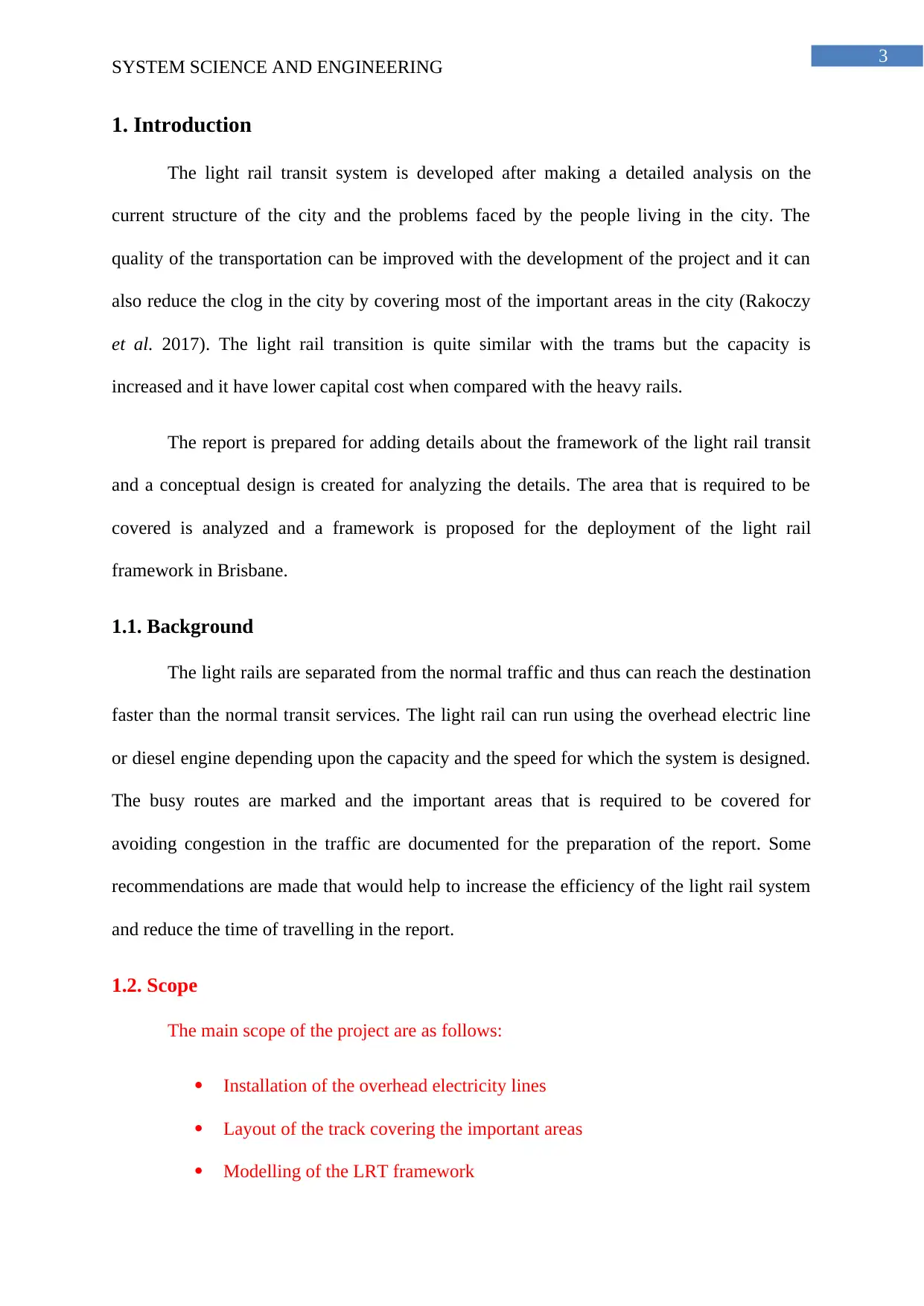
3
SYSTEM SCIENCE AND ENGINEERING
1. Introduction
The light rail transit system is developed after making a detailed analysis on the
current structure of the city and the problems faced by the people living in the city. The
quality of the transportation can be improved with the development of the project and it can
also reduce the clog in the city by covering most of the important areas in the city (Rakoczy
et al. 2017). The light rail transition is quite similar with the trams but the capacity is
increased and it have lower capital cost when compared with the heavy rails.
The report is prepared for adding details about the framework of the light rail transit
and a conceptual design is created for analyzing the details. The area that is required to be
covered is analyzed and a framework is proposed for the deployment of the light rail
framework in Brisbane.
1.1. Background
The light rails are separated from the normal traffic and thus can reach the destination
faster than the normal transit services. The light rail can run using the overhead electric line
or diesel engine depending upon the capacity and the speed for which the system is designed.
The busy routes are marked and the important areas that is required to be covered for
avoiding congestion in the traffic are documented for the preparation of the report. Some
recommendations are made that would help to increase the efficiency of the light rail system
and reduce the time of travelling in the report.
1.2. Scope
The main scope of the project are as follows:
Installation of the overhead electricity lines
Layout of the track covering the important areas
Modelling of the LRT framework
SYSTEM SCIENCE AND ENGINEERING
1. Introduction
The light rail transit system is developed after making a detailed analysis on the
current structure of the city and the problems faced by the people living in the city. The
quality of the transportation can be improved with the development of the project and it can
also reduce the clog in the city by covering most of the important areas in the city (Rakoczy
et al. 2017). The light rail transition is quite similar with the trams but the capacity is
increased and it have lower capital cost when compared with the heavy rails.
The report is prepared for adding details about the framework of the light rail transit
and a conceptual design is created for analyzing the details. The area that is required to be
covered is analyzed and a framework is proposed for the deployment of the light rail
framework in Brisbane.
1.1. Background
The light rails are separated from the normal traffic and thus can reach the destination
faster than the normal transit services. The light rail can run using the overhead electric line
or diesel engine depending upon the capacity and the speed for which the system is designed.
The busy routes are marked and the important areas that is required to be covered for
avoiding congestion in the traffic are documented for the preparation of the report. Some
recommendations are made that would help to increase the efficiency of the light rail system
and reduce the time of travelling in the report.
1.2. Scope
The main scope of the project are as follows:
Installation of the overhead electricity lines
Layout of the track covering the important areas
Modelling of the LRT framework
Paraphrase This Document
Need a fresh take? Get an instant paraphrase of this document with our AI Paraphraser
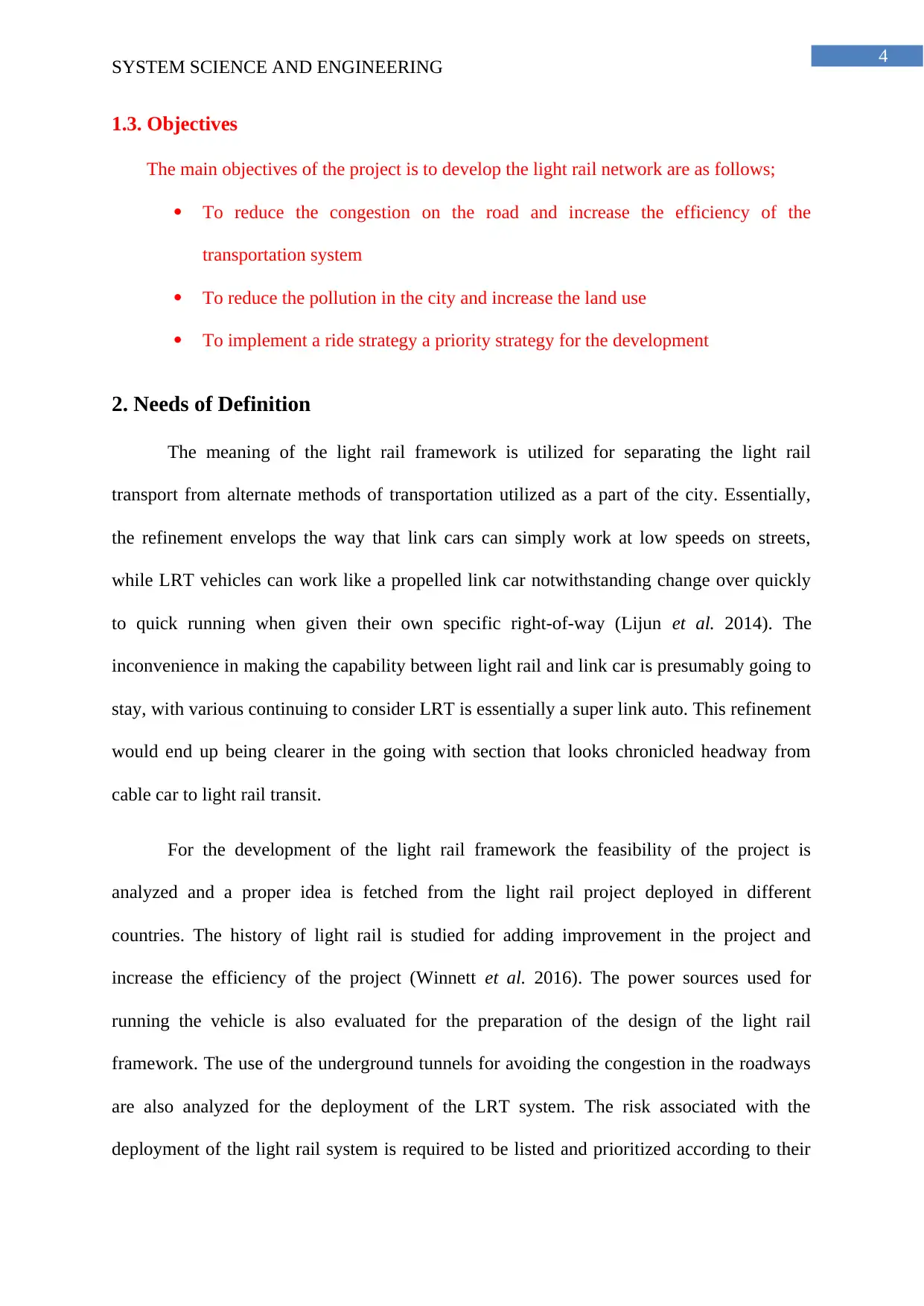
4
SYSTEM SCIENCE AND ENGINEERING
1.3. Objectives
The main objectives of the project is to develop the light rail network are as follows;
To reduce the congestion on the road and increase the efficiency of the
transportation system
To reduce the pollution in the city and increase the land use
To implement a ride strategy a priority strategy for the development
2. Needs of Definition
The meaning of the light rail framework is utilized for separating the light rail
transport from alternate methods of transportation utilized as a part of the city. Essentially,
the refinement envelops the way that link cars can simply work at low speeds on streets,
while LRT vehicles can work like a propelled link car notwithstanding change over quickly
to quick running when given their own specific right-of-way (Lijun et al. 2014). The
inconvenience in making the capability between light rail and link car is presumably going to
stay, with various continuing to consider LRT is essentially a super link auto. This refinement
would end up being clearer in the going with section that looks chronicled headway from
cable car to light rail transit.
For the development of the light rail framework the feasibility of the project is
analyzed and a proper idea is fetched from the light rail project deployed in different
countries. The history of light rail is studied for adding improvement in the project and
increase the efficiency of the project (Winnett et al. 2016). The power sources used for
running the vehicle is also evaluated for the preparation of the design of the light rail
framework. The use of the underground tunnels for avoiding the congestion in the roadways
are also analyzed for the deployment of the LRT system. The risk associated with the
deployment of the light rail system is required to be listed and prioritized according to their
SYSTEM SCIENCE AND ENGINEERING
1.3. Objectives
The main objectives of the project is to develop the light rail network are as follows;
To reduce the congestion on the road and increase the efficiency of the
transportation system
To reduce the pollution in the city and increase the land use
To implement a ride strategy a priority strategy for the development
2. Needs of Definition
The meaning of the light rail framework is utilized for separating the light rail
transport from alternate methods of transportation utilized as a part of the city. Essentially,
the refinement envelops the way that link cars can simply work at low speeds on streets,
while LRT vehicles can work like a propelled link car notwithstanding change over quickly
to quick running when given their own specific right-of-way (Lijun et al. 2014). The
inconvenience in making the capability between light rail and link car is presumably going to
stay, with various continuing to consider LRT is essentially a super link auto. This refinement
would end up being clearer in the going with section that looks chronicled headway from
cable car to light rail transit.
For the development of the light rail framework the feasibility of the project is
analyzed and a proper idea is fetched from the light rail project deployed in different
countries. The history of light rail is studied for adding improvement in the project and
increase the efficiency of the project (Winnett et al. 2016). The power sources used for
running the vehicle is also evaluated for the preparation of the design of the light rail
framework. The use of the underground tunnels for avoiding the congestion in the roadways
are also analyzed for the deployment of the LRT system. The risk associated with the
deployment of the light rail system is required to be listed and prioritized according to their
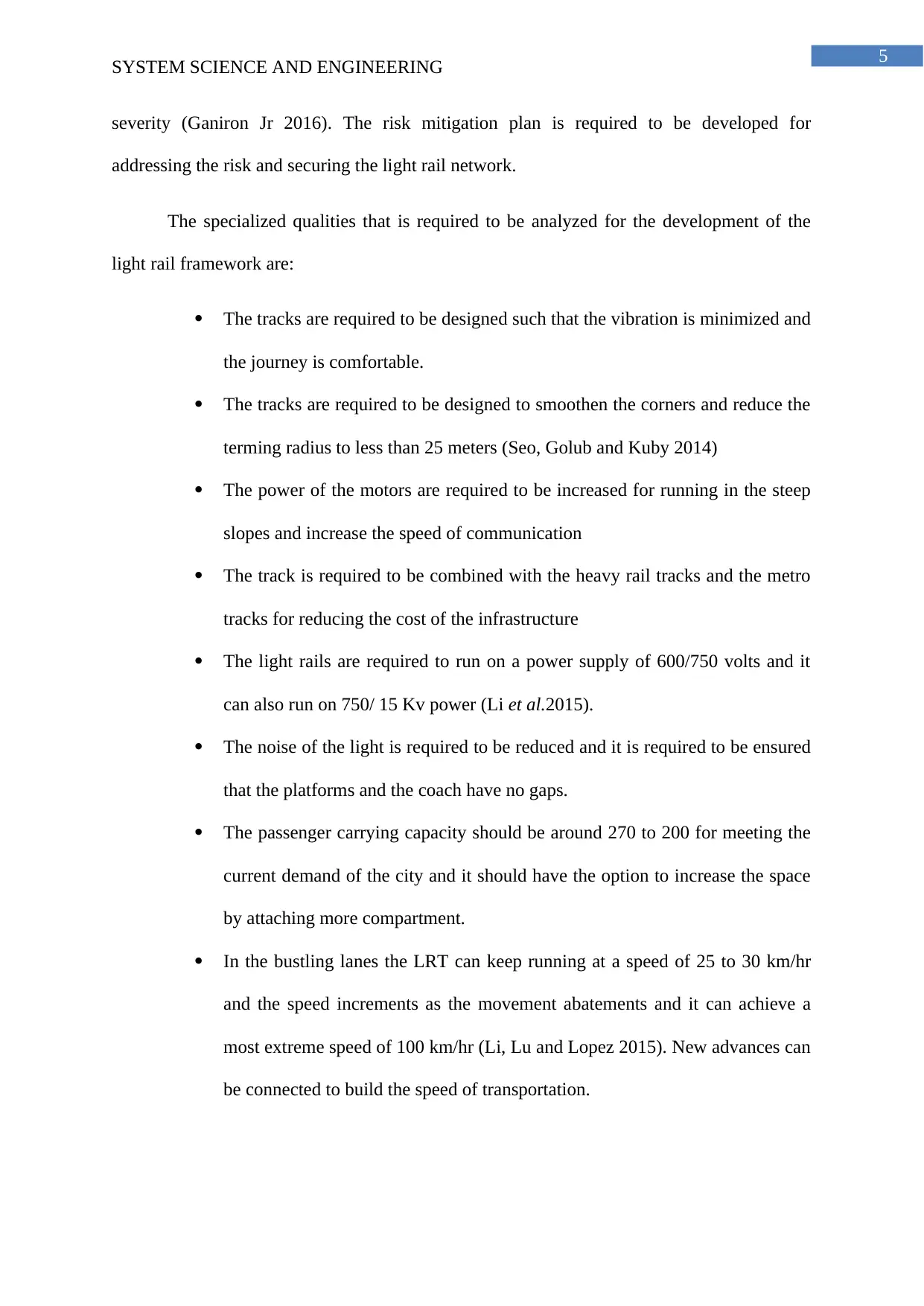
5
SYSTEM SCIENCE AND ENGINEERING
severity (Ganiron Jr 2016). The risk mitigation plan is required to be developed for
addressing the risk and securing the light rail network.
The specialized qualities that is required to be analyzed for the development of the
light rail framework are:
The tracks are required to be designed such that the vibration is minimized and
the journey is comfortable.
The tracks are required to be designed to smoothen the corners and reduce the
terming radius to less than 25 meters (Seo, Golub and Kuby 2014)
The power of the motors are required to be increased for running in the steep
slopes and increase the speed of communication
The track is required to be combined with the heavy rail tracks and the metro
tracks for reducing the cost of the infrastructure
The light rails are required to run on a power supply of 600/750 volts and it
can also run on 750/ 15 Kv power (Li et al.2015).
The noise of the light is required to be reduced and it is required to be ensured
that the platforms and the coach have no gaps.
The passenger carrying capacity should be around 270 to 200 for meeting the
current demand of the city and it should have the option to increase the space
by attaching more compartment.
In the bustling lanes the LRT can keep running at a speed of 25 to 30 km/hr
and the speed increments as the movement abatements and it can achieve a
most extreme speed of 100 km/hr (Li, Lu and Lopez 2015). New advances can
be connected to build the speed of transportation.
SYSTEM SCIENCE AND ENGINEERING
severity (Ganiron Jr 2016). The risk mitigation plan is required to be developed for
addressing the risk and securing the light rail network.
The specialized qualities that is required to be analyzed for the development of the
light rail framework are:
The tracks are required to be designed such that the vibration is minimized and
the journey is comfortable.
The tracks are required to be designed to smoothen the corners and reduce the
terming radius to less than 25 meters (Seo, Golub and Kuby 2014)
The power of the motors are required to be increased for running in the steep
slopes and increase the speed of communication
The track is required to be combined with the heavy rail tracks and the metro
tracks for reducing the cost of the infrastructure
The light rails are required to run on a power supply of 600/750 volts and it
can also run on 750/ 15 Kv power (Li et al.2015).
The noise of the light is required to be reduced and it is required to be ensured
that the platforms and the coach have no gaps.
The passenger carrying capacity should be around 270 to 200 for meeting the
current demand of the city and it should have the option to increase the space
by attaching more compartment.
In the bustling lanes the LRT can keep running at a speed of 25 to 30 km/hr
and the speed increments as the movement abatements and it can achieve a
most extreme speed of 100 km/hr (Li, Lu and Lopez 2015). New advances can
be connected to build the speed of transportation.
⊘ This is a preview!⊘
Do you want full access?
Subscribe today to unlock all pages.

Trusted by 1+ million students worldwide
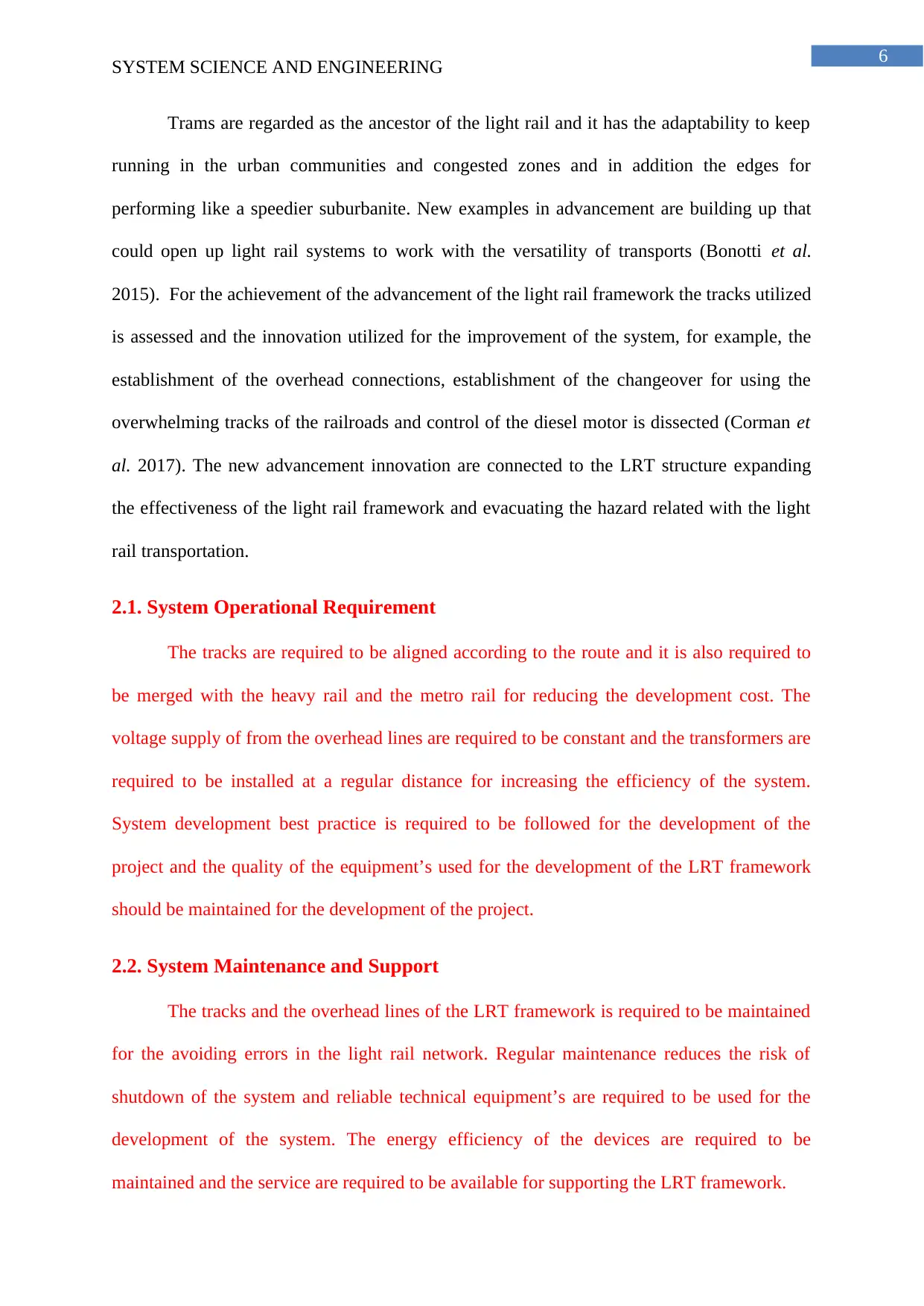
6
SYSTEM SCIENCE AND ENGINEERING
Trams are regarded as the ancestor of the light rail and it has the adaptability to keep
running in the urban communities and congested zones and in addition the edges for
performing like a speedier suburbanite. New examples in advancement are building up that
could open up light rail systems to work with the versatility of transports (Bonotti et al.
2015). For the achievement of the advancement of the light rail framework the tracks utilized
is assessed and the innovation utilized for the improvement of the system, for example, the
establishment of the overhead connections, establishment of the changeover for using the
overwhelming tracks of the railroads and control of the diesel motor is dissected (Corman et
al. 2017). The new advancement innovation are connected to the LRT structure expanding
the effectiveness of the light rail framework and evacuating the hazard related with the light
rail transportation.
2.1. System Operational Requirement
The tracks are required to be aligned according to the route and it is also required to
be merged with the heavy rail and the metro rail for reducing the development cost. The
voltage supply of from the overhead lines are required to be constant and the transformers are
required to be installed at a regular distance for increasing the efficiency of the system.
System development best practice is required to be followed for the development of the
project and the quality of the equipment’s used for the development of the LRT framework
should be maintained for the development of the project.
2.2. System Maintenance and Support
The tracks and the overhead lines of the LRT framework is required to be maintained
for the avoiding errors in the light rail network. Regular maintenance reduces the risk of
shutdown of the system and reliable technical equipment’s are required to be used for the
development of the system. The energy efficiency of the devices are required to be
maintained and the service are required to be available for supporting the LRT framework.
SYSTEM SCIENCE AND ENGINEERING
Trams are regarded as the ancestor of the light rail and it has the adaptability to keep
running in the urban communities and congested zones and in addition the edges for
performing like a speedier suburbanite. New examples in advancement are building up that
could open up light rail systems to work with the versatility of transports (Bonotti et al.
2015). For the achievement of the advancement of the light rail framework the tracks utilized
is assessed and the innovation utilized for the improvement of the system, for example, the
establishment of the overhead connections, establishment of the changeover for using the
overwhelming tracks of the railroads and control of the diesel motor is dissected (Corman et
al. 2017). The new advancement innovation are connected to the LRT structure expanding
the effectiveness of the light rail framework and evacuating the hazard related with the light
rail transportation.
2.1. System Operational Requirement
The tracks are required to be aligned according to the route and it is also required to
be merged with the heavy rail and the metro rail for reducing the development cost. The
voltage supply of from the overhead lines are required to be constant and the transformers are
required to be installed at a regular distance for increasing the efficiency of the system.
System development best practice is required to be followed for the development of the
project and the quality of the equipment’s used for the development of the LRT framework
should be maintained for the development of the project.
2.2. System Maintenance and Support
The tracks and the overhead lines of the LRT framework is required to be maintained
for the avoiding errors in the light rail network. Regular maintenance reduces the risk of
shutdown of the system and reliable technical equipment’s are required to be used for the
development of the system. The energy efficiency of the devices are required to be
maintained and the service are required to be available for supporting the LRT framework.
Paraphrase This Document
Need a fresh take? Get an instant paraphrase of this document with our AI Paraphraser
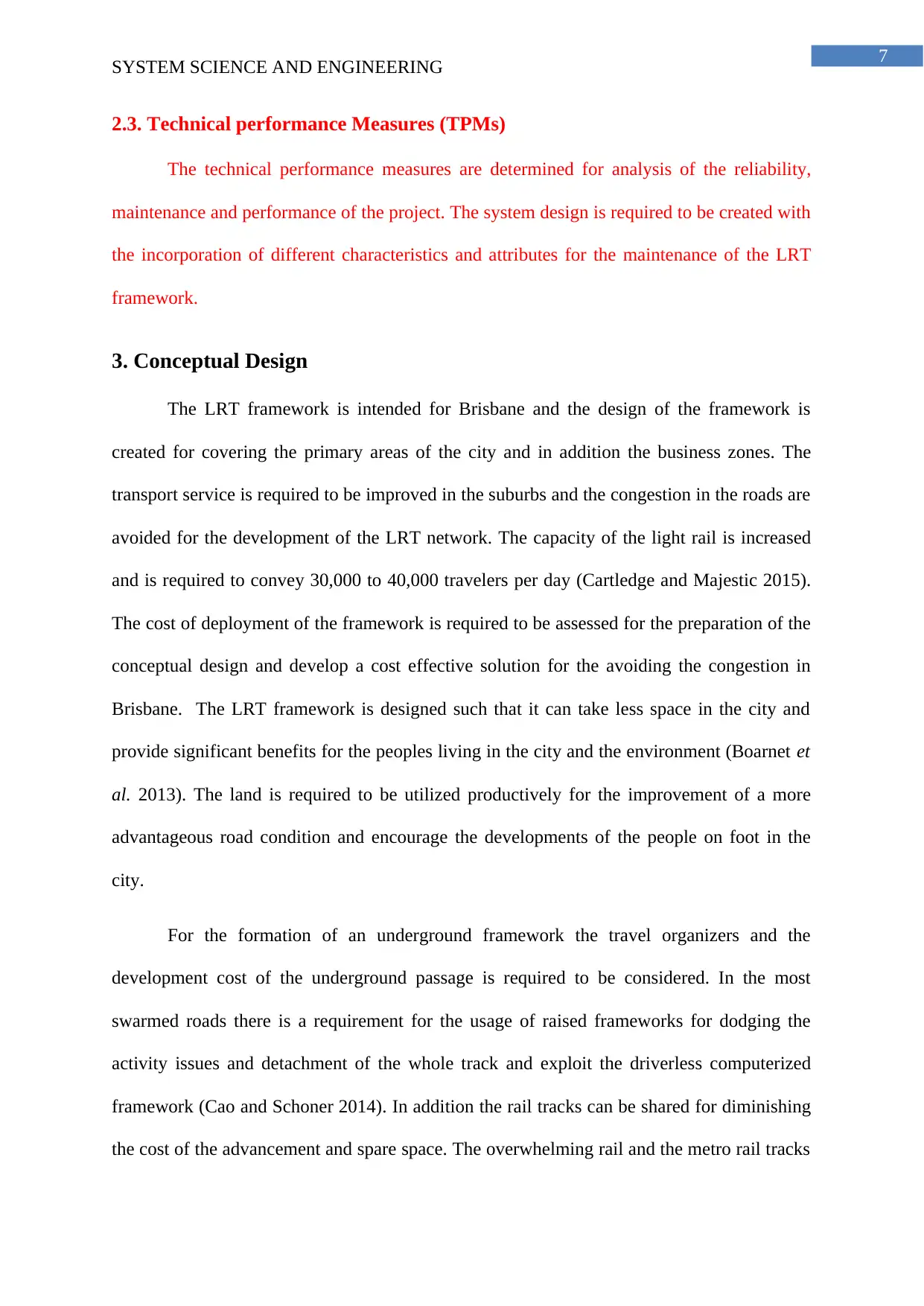
7
SYSTEM SCIENCE AND ENGINEERING
2.3. Technical performance Measures (TPMs)
The technical performance measures are determined for analysis of the reliability,
maintenance and performance of the project. The system design is required to be created with
the incorporation of different characteristics and attributes for the maintenance of the LRT
framework.
3. Conceptual Design
The LRT framework is intended for Brisbane and the design of the framework is
created for covering the primary areas of the city and in addition the business zones. The
transport service is required to be improved in the suburbs and the congestion in the roads are
avoided for the development of the LRT network. The capacity of the light rail is increased
and is required to convey 30,000 to 40,000 travelers per day (Cartledge and Majestic 2015).
The cost of deployment of the framework is required to be assessed for the preparation of the
conceptual design and develop a cost effective solution for the avoiding the congestion in
Brisbane. The LRT framework is designed such that it can take less space in the city and
provide significant benefits for the peoples living in the city and the environment (Boarnet et
al. 2013). The land is required to be utilized productively for the improvement of a more
advantageous road condition and encourage the developments of the people on foot in the
city.
For the formation of an underground framework the travel organizers and the
development cost of the underground passage is required to be considered. In the most
swarmed roads there is a requirement for the usage of raised frameworks for dodging the
activity issues and detachment of the whole track and exploit the driverless computerized
framework (Cao and Schoner 2014). In addition the rail tracks can be shared for diminishing
the cost of the advancement and spare space. The overwhelming rail and the metro rail tracks
SYSTEM SCIENCE AND ENGINEERING
2.3. Technical performance Measures (TPMs)
The technical performance measures are determined for analysis of the reliability,
maintenance and performance of the project. The system design is required to be created with
the incorporation of different characteristics and attributes for the maintenance of the LRT
framework.
3. Conceptual Design
The LRT framework is intended for Brisbane and the design of the framework is
created for covering the primary areas of the city and in addition the business zones. The
transport service is required to be improved in the suburbs and the congestion in the roads are
avoided for the development of the LRT network. The capacity of the light rail is increased
and is required to convey 30,000 to 40,000 travelers per day (Cartledge and Majestic 2015).
The cost of deployment of the framework is required to be assessed for the preparation of the
conceptual design and develop a cost effective solution for the avoiding the congestion in
Brisbane. The LRT framework is designed such that it can take less space in the city and
provide significant benefits for the peoples living in the city and the environment (Boarnet et
al. 2013). The land is required to be utilized productively for the improvement of a more
advantageous road condition and encourage the developments of the people on foot in the
city.
For the formation of an underground framework the travel organizers and the
development cost of the underground passage is required to be considered. In the most
swarmed roads there is a requirement for the usage of raised frameworks for dodging the
activity issues and detachment of the whole track and exploit the driverless computerized
framework (Cao and Schoner 2014). In addition the rail tracks can be shared for diminishing
the cost of the advancement and spare space. The overwhelming rail and the metro rail tracks
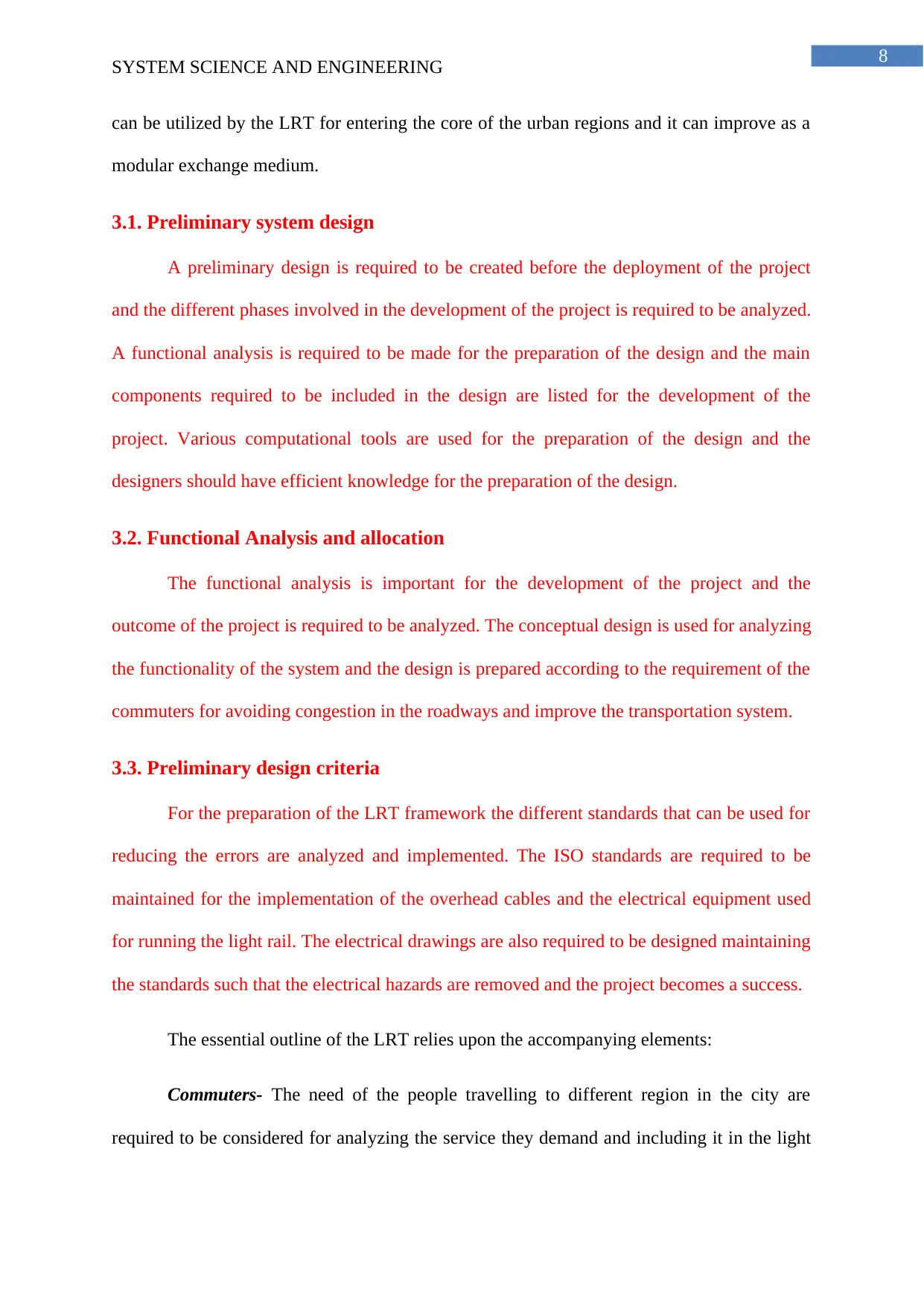
8
SYSTEM SCIENCE AND ENGINEERING
can be utilized by the LRT for entering the core of the urban regions and it can improve as a
modular exchange medium.
3.1. Preliminary system design
A preliminary design is required to be created before the deployment of the project
and the different phases involved in the development of the project is required to be analyzed.
A functional analysis is required to be made for the preparation of the design and the main
components required to be included in the design are listed for the development of the
project. Various computational tools are used for the preparation of the design and the
designers should have efficient knowledge for the preparation of the design.
3.2. Functional Analysis and allocation
The functional analysis is important for the development of the project and the
outcome of the project is required to be analyzed. The conceptual design is used for analyzing
the functionality of the system and the design is prepared according to the requirement of the
commuters for avoiding congestion in the roadways and improve the transportation system.
3.3. Preliminary design criteria
For the preparation of the LRT framework the different standards that can be used for
reducing the errors are analyzed and implemented. The ISO standards are required to be
maintained for the implementation of the overhead cables and the electrical equipment used
for running the light rail. The electrical drawings are also required to be designed maintaining
the standards such that the electrical hazards are removed and the project becomes a success.
The essential outline of the LRT relies upon the accompanying elements:
Commuters- The need of the people travelling to different region in the city are
required to be considered for analyzing the service they demand and including it in the light
SYSTEM SCIENCE AND ENGINEERING
can be utilized by the LRT for entering the core of the urban regions and it can improve as a
modular exchange medium.
3.1. Preliminary system design
A preliminary design is required to be created before the deployment of the project
and the different phases involved in the development of the project is required to be analyzed.
A functional analysis is required to be made for the preparation of the design and the main
components required to be included in the design are listed for the development of the
project. Various computational tools are used for the preparation of the design and the
designers should have efficient knowledge for the preparation of the design.
3.2. Functional Analysis and allocation
The functional analysis is important for the development of the project and the
outcome of the project is required to be analyzed. The conceptual design is used for analyzing
the functionality of the system and the design is prepared according to the requirement of the
commuters for avoiding congestion in the roadways and improve the transportation system.
3.3. Preliminary design criteria
For the preparation of the LRT framework the different standards that can be used for
reducing the errors are analyzed and implemented. The ISO standards are required to be
maintained for the implementation of the overhead cables and the electrical equipment used
for running the light rail. The electrical drawings are also required to be designed maintaining
the standards such that the electrical hazards are removed and the project becomes a success.
The essential outline of the LRT relies upon the accompanying elements:
Commuters- The need of the people travelling to different region in the city are
required to be considered for analyzing the service they demand and including it in the light
⊘ This is a preview!⊘
Do you want full access?
Subscribe today to unlock all pages.

Trusted by 1+ million students worldwide
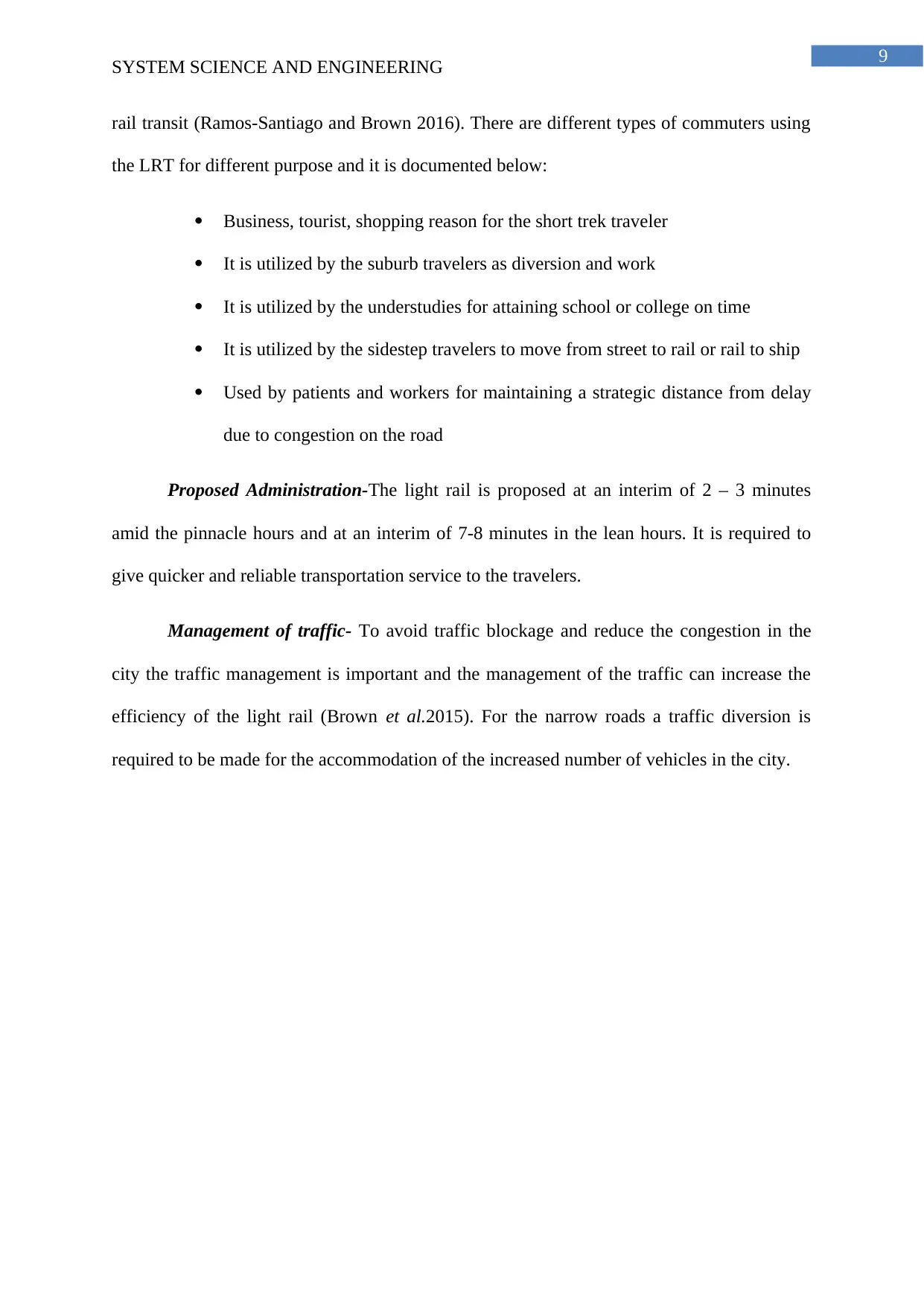
9
SYSTEM SCIENCE AND ENGINEERING
rail transit (Ramos-Santiago and Brown 2016). There are different types of commuters using
the LRT for different purpose and it is documented below:
Business, tourist, shopping reason for the short trek traveler
It is utilized by the suburb travelers as diversion and work
It is utilized by the understudies for attaining school or college on time
It is utilized by the sidestep travelers to move from street to rail or rail to ship
Used by patients and workers for maintaining a strategic distance from delay
due to congestion on the road
Proposed Administration-The light rail is proposed at an interim of 2 – 3 minutes
amid the pinnacle hours and at an interim of 7-8 minutes in the lean hours. It is required to
give quicker and reliable transportation service to the travelers.
Management of traffic- To avoid traffic blockage and reduce the congestion in the
city the traffic management is important and the management of the traffic can increase the
efficiency of the light rail (Brown et al.2015). For the narrow roads a traffic diversion is
required to be made for the accommodation of the increased number of vehicles in the city.
SYSTEM SCIENCE AND ENGINEERING
rail transit (Ramos-Santiago and Brown 2016). There are different types of commuters using
the LRT for different purpose and it is documented below:
Business, tourist, shopping reason for the short trek traveler
It is utilized by the suburb travelers as diversion and work
It is utilized by the understudies for attaining school or college on time
It is utilized by the sidestep travelers to move from street to rail or rail to ship
Used by patients and workers for maintaining a strategic distance from delay
due to congestion on the road
Proposed Administration-The light rail is proposed at an interim of 2 – 3 minutes
amid the pinnacle hours and at an interim of 7-8 minutes in the lean hours. It is required to
give quicker and reliable transportation service to the travelers.
Management of traffic- To avoid traffic blockage and reduce the congestion in the
city the traffic management is important and the management of the traffic can increase the
efficiency of the light rail (Brown et al.2015). For the narrow roads a traffic diversion is
required to be made for the accommodation of the increased number of vehicles in the city.
Paraphrase This Document
Need a fresh take? Get an instant paraphrase of this document with our AI Paraphraser
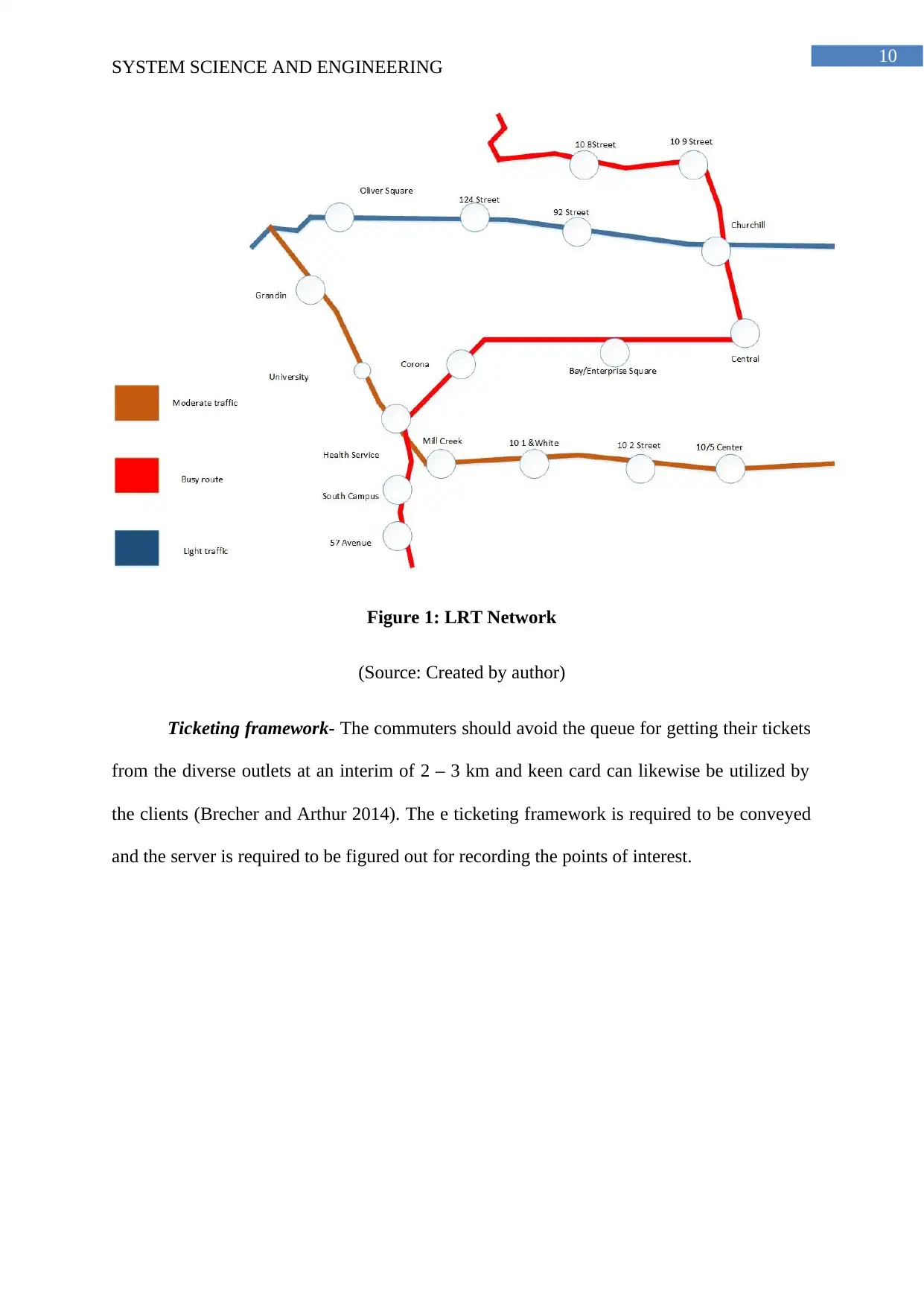
10
SYSTEM SCIENCE AND ENGINEERING
Figure 1: LRT Network
(Source: Created by author)
Ticketing framework- The commuters should avoid the queue for getting their tickets
from the diverse outlets at an interim of 2 – 3 km and keen card can likewise be utilized by
the clients (Brecher and Arthur 2014). The e ticketing framework is required to be conveyed
and the server is required to be figured out for recording the points of interest.
SYSTEM SCIENCE AND ENGINEERING
Figure 1: LRT Network
(Source: Created by author)
Ticketing framework- The commuters should avoid the queue for getting their tickets
from the diverse outlets at an interim of 2 – 3 km and keen card can likewise be utilized by
the clients (Brecher and Arthur 2014). The e ticketing framework is required to be conveyed
and the server is required to be figured out for recording the points of interest.
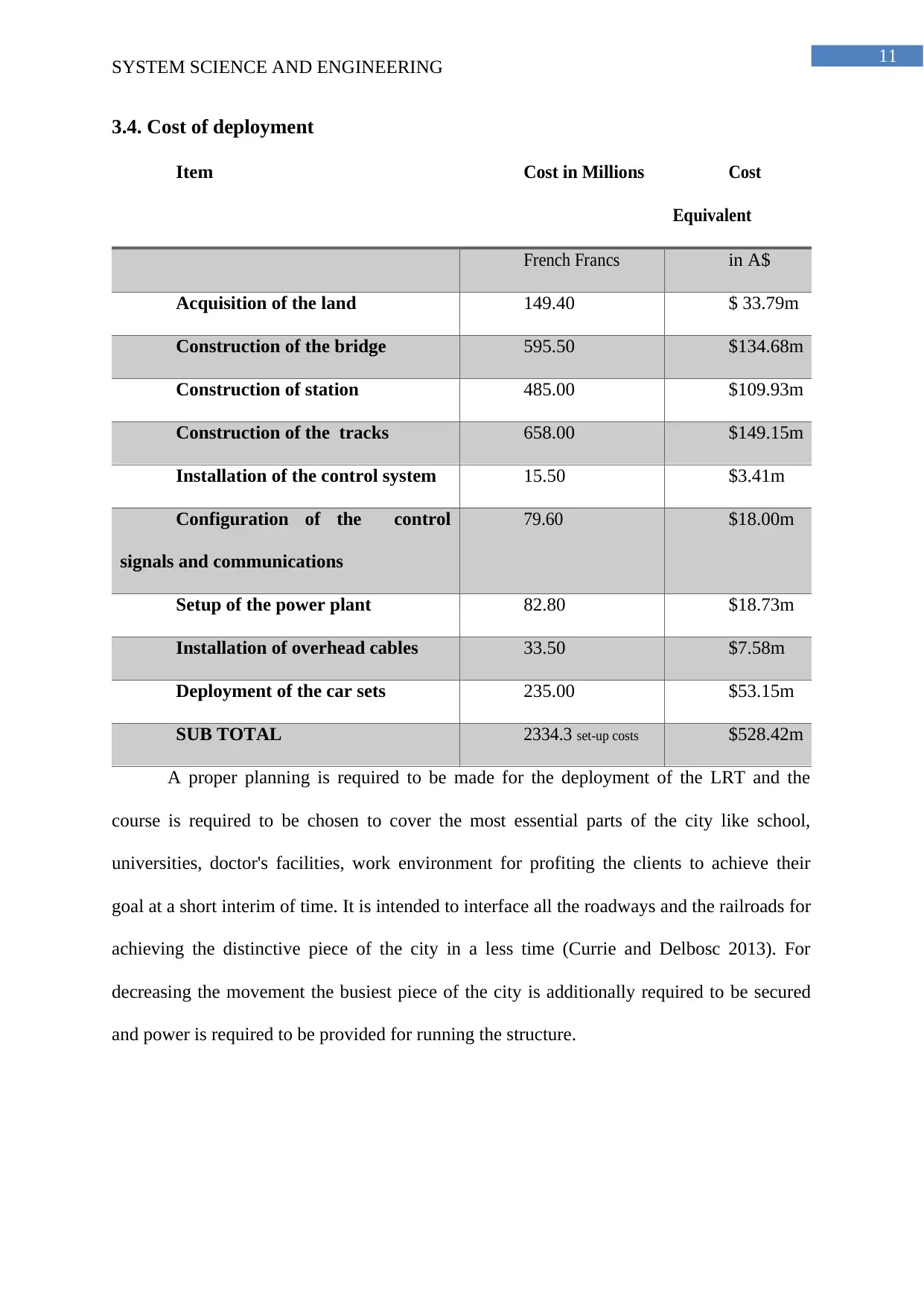
11
SYSTEM SCIENCE AND ENGINEERING
3.4. Cost of deployment
Item Cost in Millions Cost
Equivalent
French Francs in A$
Acquisition of the land 149.40 $ 33.79m
Construction of the bridge 595.50 $134.68m
Construction of station 485.00 $109.93m
Construction of the tracks 658.00 $149.15m
Installation of the control system 15.50 $3.41m
Configuration of the control
signals and communications
79.60 $18.00m
Setup of the power plant 82.80 $18.73m
Installation of overhead cables 33.50 $7.58m
Deployment of the car sets 235.00 $53.15m
SUB TOTAL 2334.3 set-up costs $528.42m
A proper planning is required to be made for the deployment of the LRT and the
course is required to be chosen to cover the most essential parts of the city like school,
universities, doctor's facilities, work environment for profiting the clients to achieve their
goal at a short interim of time. It is intended to interface all the roadways and the railroads for
achieving the distinctive piece of the city in a less time (Currie and Delbosc 2013). For
decreasing the movement the busiest piece of the city is additionally required to be secured
and power is required to be provided for running the structure.
SYSTEM SCIENCE AND ENGINEERING
3.4. Cost of deployment
Item Cost in Millions Cost
Equivalent
French Francs in A$
Acquisition of the land 149.40 $ 33.79m
Construction of the bridge 595.50 $134.68m
Construction of station 485.00 $109.93m
Construction of the tracks 658.00 $149.15m
Installation of the control system 15.50 $3.41m
Configuration of the control
signals and communications
79.60 $18.00m
Setup of the power plant 82.80 $18.73m
Installation of overhead cables 33.50 $7.58m
Deployment of the car sets 235.00 $53.15m
SUB TOTAL 2334.3 set-up costs $528.42m
A proper planning is required to be made for the deployment of the LRT and the
course is required to be chosen to cover the most essential parts of the city like school,
universities, doctor's facilities, work environment for profiting the clients to achieve their
goal at a short interim of time. It is intended to interface all the roadways and the railroads for
achieving the distinctive piece of the city in a less time (Currie and Delbosc 2013). For
decreasing the movement the busiest piece of the city is additionally required to be secured
and power is required to be provided for running the structure.
⊘ This is a preview!⊘
Do you want full access?
Subscribe today to unlock all pages.

Trusted by 1+ million students worldwide
1 out of 18
Related Documents
Your All-in-One AI-Powered Toolkit for Academic Success.
+13062052269
info@desklib.com
Available 24*7 on WhatsApp / Email
![[object Object]](/_next/static/media/star-bottom.7253800d.svg)
Unlock your academic potential
Copyright © 2020–2025 A2Z Services. All Rights Reserved. Developed and managed by ZUCOL.





